Say, did you know that the name of the palace around which this update revolves — Parapa — is one letter removed from the name of a popular PlayStation character? Yep. Glad we could get that out of the way.
Despite what I wrote in the previous update about the opening screen of Zelda II offering fewer and less complex choices than the first screen of The Legend of Zelda, this doesn’t mean the series’ first sequel dumbed things down or reduced the complexity of the experience. On the contrary, I’d say it’s far more complex. Once you step into the world map view, you’re presented with a large number of possible choices. If you take the road immediately east from the starting temple, you’ll wind around and come to Rauru, the first town, where you’ll be able to gather some essential clues to progressing. But as a product of an era far predating tutorials and hand-holding, Zelda II also gives you a number of other choices with no indication as to which is the right one.
You can travel to no less than four different caves from the outset, though without the means to light up the dark two of them are effectively impassible. The easiest cave to traverse — it’s occupied by a single beetle (crustacean?) that roams back and forth and is incredibly unlikely to finish off the rawest novice of a player even if it catches them completely off-guard — happens to be the path forward. The game coaxes you in the right direction by throwing the lowest barrier along the critical path, though it would work better if this path didn’t have a single creature inside to potentially discourage explorers. Another cave contains a fair number of low-end monsters that can be defended against by a cautious player (enemies in dark caverns are black on black, yet their silhouettes overlap slightly against the blue of the floor, and their projectiles appear fairly clearly) and contains a boost to Link’s magic meter at the end.
The other two caves, however, are essentially deathtraps without the benefit of illumination.
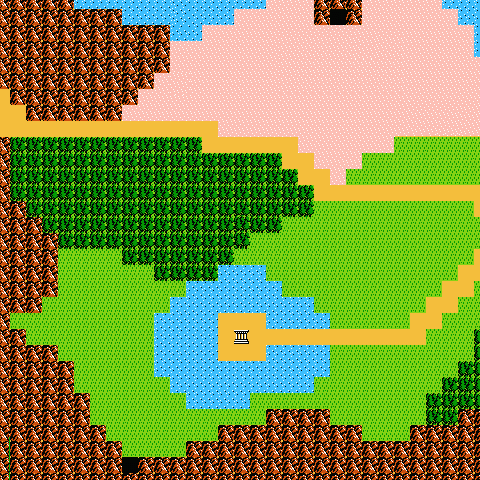
There’s also a second town to the northwest. The presence of two villages within this blocked-off starting region (the paths forward are obstructed by both one of those impassable caves and a huge boulder that cannot yet be destroyed) begins to communicate Zelda II‘s sense of scale. Meanwhile, three different combat environments appear here as well, offering six different random battle scenarios in addition to the fixed encounter surrounding the lone tree to the north, where you can snag a pouch of experience. (Yes, experience points are the closest thing to currency this time, Rupees having been completely phased out.)
So, within the first couple of minutes of Zelda II, you have practically all the game’s ingredients presented. You experience the modal switch between the top-down and side-scrolling points of view. You see both combat and exploration. You get the knack of gathering clues from townies, acquire your first magic spell, learn the nature of the game’s environmental obstructions (both scenery, like the boulder, and situational, as in the dark caverns). You can collect a single bag of experience that will take Link to his first level-up. It’s a little of everything… and honestly, it can be a little overwhelming.
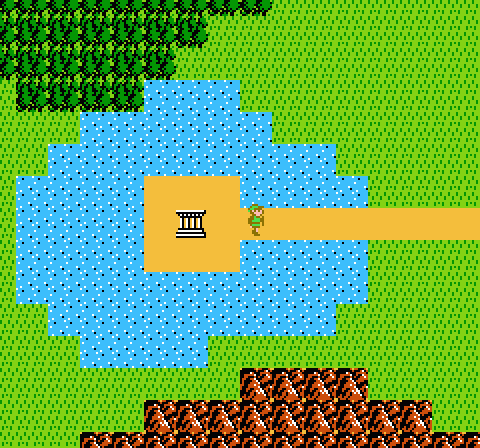
Because Zelda II makes no effort to hold your hand, its complexities take some getting used to. We’re accustomed to such brash blending of genres as seen in this early action-RPG today, of course, but in 1987 (or 1988 in the U.S.) this style of fusion design was largely unheard of. Zelda’s combat plays similarly to Rastan Saga or Dragon Buster, but its RPG roots run far deeper. It doesn’t help that the Link has two different mechanisms for improving his skills: He both levels up by gathering experience and collects Heart and Magic Containers as well. This can be a little confusing even now. The containers boost his maximum levels, while the experience gains serve a purpose not unlike the rings in the first Zelda. When you level one of Link’s parameters, it cuts the cost to health or magic when you take a hit or cast a spell. Only the strength stat enjoys an obvious up-front improvement on leveling up. It’s a strange system, but it makes a kind of sense. Still, it took some sorting out back in the day.
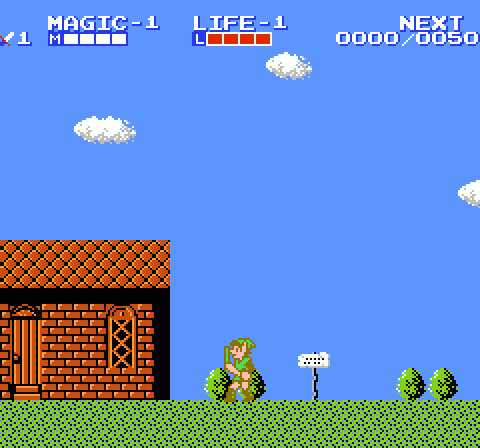
Thankfully, the villagers of Hyrule are a lot more helpful and forthcoming than those of Transylvania. At worst, they’ll apologize for being unable to help, and they’ll often give you advice and items to aid your quest. Compare that to the outright liars of Simon’s Quest (which arrived about half a year later than Adventure of Link) and it’s quite the improvement. Each village has a standard set of citizens: The hunched middle-aged man who gives advice, the elderly sage who provides magic, the pretty lady who mysteriously takes Link into her home to restore his health, etc. While Zelda II doesn’t hold the player’s hand at all, thoroughly speaking to everyone will provide more than sufficient pointers to lead you along.
Outside of town, combat springs into action anytime Link contacts an enemy icon. Again, each field type (forest, plain, swamp, desert, etc.) contains two distinct mixes of enemy formations based on whether you bump into a weak or strong encounter. The “weak” foes in this portion of the game actually are more trouble than they’re worth — they generally contain infinitely respawning enemies or hazards capable of doing Link harm but offering no experience points in return. As such, I try to avoid the slime icons in favor of the moblin icons, since the latter pay out more rewards and aren’t particularly more difficult than the weaker encounters.
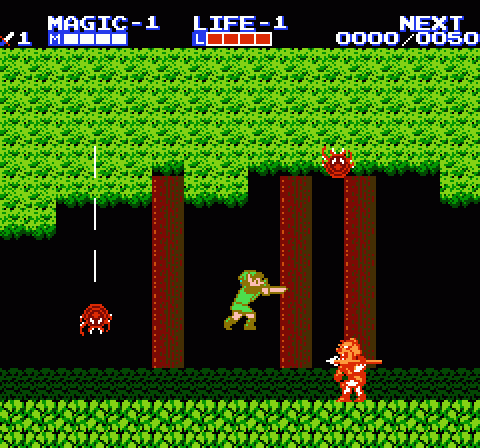
Ultimately, though, you can’t move beyond the opening region until you tackle its palace, Parapa. Palaces play the same essential role as Zelda‘s dungeons: They’re packed with danger, contain treasures, require the use of keys to slip past locked doors, and feature a boss guarding a mystical artifact (in this case, a statue into which a gem must be inserted). They’re heavily centered around combat and navigation, though the side-scrolling nature of the game makes them far twitchier (and, for most players, more challenging) than the slower, more maze-like stages of the first game.
Parapa Palace gets the ball rolling by presenting players with a surprisingly large and difficult dungeon to complete on their first go. The complexity of this dungeon bodes ill for subsequent levels: The thing is fairly huge, with several tough foes and side passages that lead to optional, if essential, items. As in Zelda, the creatures that occupy the dungeons greatly outstrip the foes of the overworld in power and aggressiveness. Of particular note are the Stalfos and the Ironknuckles (effectively a revamp of Zelda‘s Darknuts), both of which take the form of humanoid foes who can use Link’s own sword-and-shield skills against him. The Stalfos is fairly easy, as it always holds its shield high and stabs at head level; defeating it is a simple matter of blocking its attacks and ducking between its blows to strike its unprotected legs. The Ironknuckles, however, pose a much greater threat: They can block and stab both high and low, and independently at that. Even Link can’t do that. Throughout the game, Ironknuckles will pose the single greatest threat players have to face — often even more dangerous than the bosses.
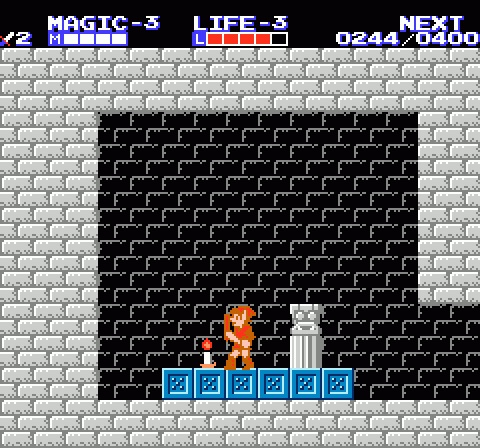
The most important thing hidden in Parapa isn’t the statue into which you must set your gem; no, it’s the Candle that casts light into darkened tunnels and caverns. You can make it all the way to the entrance of the final dungeon without placing those magic gems, but good luck getting past the town of Ruto without this thing. Naturally, it waits in the lowest level of the palace in the opposite direction from the statue, which makes it easy to overlook. Nintendo pulled this little trick with the treasures in Zelda, too, but at least that game had the courtesy to offer dungeon mini-maps to help guide your way and give a hint of what you’d overlooked. Zelda II offers no such luxury.
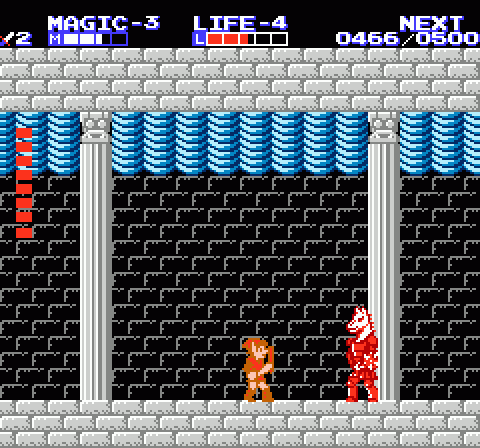
At the end of the dungeon waits the first boss, who also fights not unlike Link, though with a mace rather than a sword. Should you be unfortunate enough to take a hit from the mace, it’ll fling you backward. Fortunately, it’s pretty easy to work up a simple strategy of jumping at its head and smacking this horse dude in the face before ducking back to avoid the reciprocal macing.
With the boss down, you’re free to move along and explore new regions of the game — though as in Zelda, it’s not the boss’ defeat or the magical artifact you find behind him that opens the road ahead but rather the item you collected within the dungeon. This approach to design has long since evaporated from the Zelda games, as progress in modern titles is handed out as a reward for reaching certain story checkpoints that generally unlock by completing a dungeon. But, as with so many things in Zelda II, these rules and systems were still in development here. Sometimes that means Zelda II feels cumbersome and amateurish, but sometimes it’s refreshingly open and adventuresome, too. Just like the attract mode promised.
Damn, I’m loving this. Can’t wait for the print version of the Zelda Anatomies.
Love these Anatomy articles. I bought two copies of your vol Castlevania book (one as a gift) and am enjoying that read as well. My only concern is the lack of proof-reading. There are a few minor edits that need to be made in almost every article:
“It doesn’t help that the Link has two different…”
The “the Link” for example in this very article. I’m hoping that these errors don’t make it into the next volume as frequently as they did with Castlevania. Other than that- love the content!
According to Hyrule Historia, the towns in Zelda 2 are named Saria, Darunia, Ruto, Impa, Nabooru and Rauru, which are also the names of the Six Sages in Ocarina of Time. Is that true, or something Nintendo ret-conned in later to make it look they’ve planned everything from the start.
No, that’s been the case all along. The Kokiri had the same names as Zelda’s towns from the start and people noticed the connection right away.
You know, you don’t even have to return the gems to the statues to move through the game, and there’s a great incentive not to: You level-up every time automatically each time you return a stone, and if you wait until all of your levels are at 6, you’ll avoid a lot of irritating grinding. When I replayed Zelda II on the Wii, that’s what I did, and it made the overall experience significantly more enjoyable.
Ed - it’s ever better if you time your grind so the boss levels you up. Then the gem provides an entire free upgrade immediately following. I generally level up 6 times by the time I leave Palace 1, and I’m maxed by Palace 5.
Secret #2: Kill every Bubble.
I freaking hate Bubbles.
Yeah, I usually do it Tomm’s way.
And oh, if only Ironknuckles were the worst enemy you faced…